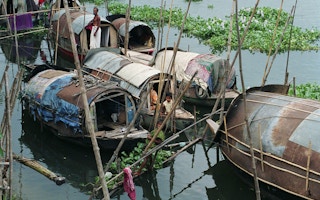Khaleda Sultana’s small workshop in Dhaka, where she makes homeware and handicrafts from jute and other plant fibres, is far from the coastal areas of Bangladesh that are struggling to cope with rising seas and powerful storms.
But, she says, her business still needs to adapt to worsening climate change impacts.
“I have to count losses when the coasts are flooded and my remote subcontractor workers there have to go looking for shelter, or when rainfall becomes irregular and it affects the quality of fibre that we use,” Sultana said.
The question of how to withstand more extreme weather and encroaching oceans is growing increasingly urgent for many Bangladeshis - from those living on disappearing delta islands to migrants in city slums - as the planet’s climate heats up.
It is a challenge the government hopes to tackle with its first National Adaptation Plan (NAP), which is set to be approved by the cabinet in the run-up to November’s COP27 UN climate change conference in Egypt.
“Bangladesh has been a pioneer in climate strategy among the developing countries,” said Ahmmed Zulfiqar Rahaman, a climate expert with the Centre for Environmental and Geographic Information Services (CEGIS) who helped draft the plan.
The country was widely applauded for its earlier national climate change strategy in 2009, which was financed through a dedicated national climate fund, the first of its kind set up by a member of the UN-defined Least Developed Countries group.
Small businesses struggling
A study by the London-based International Institute for Environment and Development, published in May, showed rural families in Bangladesh use a large chunk of their budgets to protect themselves from climate change, especially households led by women, who allocate up to 30 per cent of their spending for that purpose.
Measures that rural Bangladeshis commonly invest in include raising the plinth of their home above flood-water levels, planting trees and making shelters to keep livestock safe.
“
Bangladesh has been a pioneer in climate strategy among the developing countries.
Ahmmed Zulfiqar Rahaman, climate expert, Centre for Environmental and Geographic Information Services
Climate and aid experts said many affected families do not receive adequate support during and after natural disasters.
Shingraj, a factory worker in the eastern city of Sylhet who goes by one name, said he and his brother struggled to cope when flooding hit their home in June.
“We did not receive any aid, being located in a remote corner of the country, and we could not go to work either as long as our locality was inundated,” he said.
In an effort to make sure the NAP will help people like Shingraj, experts held a series of workshops to talk to local government representatives, businesses and citizens, said Dwijen Mallick at the Bangladesh Centre for Advanced Studies, one of the key experts who drafted the document.
Business owners said the government should ensure adaptation efforts help Bangladesh’s roughly 8 million mainly small and medium businesses, which have received little support so far.
Md. Abul Hasan, managing director of a textile factory in Khulna, said rising seas are contaminating agricultural land along the coast with saltwater, which is hurting fabric quality.
A government initiative to supply clean river water to places affected by salinity is commendable, he added, but it has not reached many smaller businesses, including his own.
“We need huge investment from the government to create alternative employment as salinity erodes agricultural productivity,” he noted.
Climate interventions
Bangladesh’s new plan identifies more than 110 adaptation measures to tackle climate stresses such as cyclones, floods, droughts, sea level rise and saltwater intrusion, said Rahaman of the CEGIS.
It requires an estimated investment of $230 billion between 2023 and 2050 - seven times more than the country is spending on its national climate change strategy now, according to Rahaman.
The bulk of the funding is expected to come from global climate finance pools, such as the Green Climate Fund, as well as international aid, with Bangladesh’s government and private sector making up the balance, he added.
The plan seeks to protect 1.1 million hectares (2.7 million acres) of cropland from floods by better maintaining dikes and polders - land surrounded by embankments - and improving water management.
Urban areas will be bolstered against climate disasters with city-level efforts that include more robust infrastructure design and updated drainage systems.
According to the World Bank Group, by 2050, climate change impacts could force up to 19.9 million Bangladeshis to flee their homes and move to another part of the country.
To avoid such mass migration, the NAP outlines interventions for reducing climate risks to vulnerable communities - such as those living in urban slums - and creating alternative livelihoods for the people who are hardest hit.
Jute producer Sultana said to make these efforts effective, the government needs to strengthen policies to assist smaller businesses, for example, by making it easier and simpler to get loan approvals and other financial services.
But for Sohanur Rahman, executive coordinator of YouthNet for Climate Justice, a local activist group, the key to the new plan’s success lies with Bangladesh’s young people.
Youth activists were consulted during the formulation of the NAP, and the draft makes a commitment to engage young people in the country’s efforts to adapt to climate change, Rahman said.
But unless that happens in practice, “the plan will not bear fruit”, he warned.
This story was published with permission from Thomson Reuters Foundation, the charitable arm of Thomson Reuters, that covers humanitarian news, climate change, resilience, women’s rights, trafficking and property rights. Visit https://www.context.news/.

















